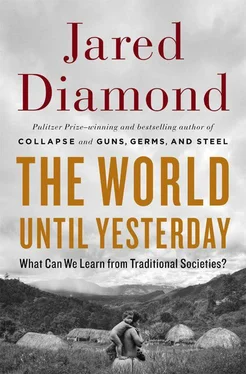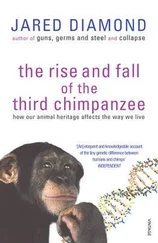Jared Diamond

THE
WORLD
UNTIL
YESTERDAY

WHAT CAN WE LEARN FROM TRADITIONAL SOCIETIES?
To
Meg Taylor,
in appreciation for decades
of your friendship,
and of sharing your insights into our two worlds
List of Tables and Figures
Figure 1Locations of 39 societies that will be discussed frequently in this book
Table 1.1Objects traded by some traditional societies
Table 3.1Membership of two warring Dani alliances
Table 8.1Causes of accidental death and injury
Table 8.2Traditional food storage around the world
Table 9.1Some proposed definitions of religion
Table 9.2Examples of supernatural beliefs confined to particular religions
Figure 9.1Religion’s functions changing through time
Table 11.1Prevalences of Type-2 diabetes around the world
Table 11.2Examples of gluttony when food is abundantly available
An airport scene

Why study traditional societies?

States

Types of traditional societies

Approaches, causes, and sources

A small book about a big subject

Plan of the book
April 30, 2006, 7:00 A.M. I’m in an airport’s check-in hall, gripping my baggage cart while being jostled by a crowd of other people also checking in for that morning’s first flights. The scene is familiar: hundreds of travelers carrying suitcases, boxes, backpacks, and babies, forming parallel lines approaching a long counter, behind which stand uniformed airline employees at their computers. Other uniformed people are scattered among the crowd: pilots and stewardesses, baggage screeners, and two policemen swamped by the crowd and standing with nothing to do except to be visible. The screeners are X-raying luggage, airline employees tag the bags, and baggage handlers put the bags onto a conveyor belt carrying them off, hopefully to end up in the appropriate airplanes. Along the wall opposite the check-in counter are shops selling newspapers and fast food. Still other objects around me are the usual wall clocks, telephones, ATMs, escalators to the upper level, and of course airplanes on the runway visible through the terminal windows.
The airline clerks are moving their fingers over computer keyboards and looking at screens, punctuated by printing credit-card receipts at credit-card terminals. The crowd exhibits the usual mixture of good humor, patience, exasperation, respectful waiting on line, and greeting friends. When I reach the head of my line, I show a piece of paper (my flight itinerary) to someone I’ve never seen before and will probably never see again (a check-in clerk). She in turn hands me a piece of paper giving me permission to fly hundreds of miles to a place that I’ve never visited before, and whose inhabitants don’t know me but will nevertheless tolerate my arrival.
To travelers from the U.S., Europe, or Asia, the first feature that would strike them as distinctive about this otherwise familiar scene is that all the people in the hall except myself and a few other tourists are New Guineans. Other differences that would be noted by overseas travelers are that the national flag over the counter is the black, red, and gold flag of the nation of Papua New Guinea, displaying a bird of paradise and the constellation of the Southern Cross; the counter airline signs don’t say American Airlines or British Airways but Air Niugini; and the names of the flight destinations on the screens have an exotic ring: Wapenamanda, Goroka, Kikori, Kundiawa, and Wewak.
The airport at which I was checking in that morning was that of Port Moresby, capital of Papua New Guinea. To anyone with a sense of New Guinea’s history—including me, who first came to Papua New Guinea in 1964 when it was still administered by Australia—the scene was at once familiar, astonishing, and moving. I found myself mentally comparing the scene with the photographs taken by the first Australians to enter and “discover” New Guinea’s Highlands in 1931, teeming with a million New Guinea villagers still then using stone tools. In those photographs the Highlanders, who had been living for millennia in relative isolation with limited knowledge of an outside world, stare in horror at their first sight of Europeans ( Plates 30, 31). I looked at the faces of those New Guinea passengers, counter clerks, and pilots at Port Moresby airport in 2006, and I saw in them the faces of the New Guineans photographed in 1931. The people standing around me in the airport were of course not the same individuals of the 1931 photographs, but their faces were similar, and some of them may have been their children and grandchildren.
The most obvious difference between that 2006 check-in scene etched in my memory, and the 1931 photographs of “first contact,” is that New Guinea Highlanders in 1931 were scantily clothed in grass skirts, net bags over their shoulders, and headdresses of bird feathers, but in 2006 they wore the standard international garb of shirts, trousers, skirts, shorts, and baseball caps. Within a generation or two, and within the individual lives of many people in that airport hall, New Guinea Highlanders learned to write, use computers, and fly airplanes. Some of the people in the hall might actually have been the first people in their tribe to have learned reading and writing. That generation gap was symbolized for me by the image of two New Guinea men in the airport crowd, the younger leading the older: the younger in a pilot’s uniform, explaining to me that he was taking the older one, his grandfather, for the old man’s first flight in an airplane; and the gray-haired grandfather looking almost as bewildered and overwhelmed as the people in the 1931 photos.
But an observer familiar with New Guinea history would have recognized bigger differences between the 1931 and 2006 scenes, beyond the fact that people wore grass skirts in 1931 and Western garb in 2006. New Guinea Highland societies in 1931 lacked not just manufactured clothing but also all modern technologies, from clocks, phones, and credit cards to computers, escalators, and airplanes. More fundamentally, the New Guinea Highlands of 1931 lacked writing, metal, money, schools, and centralized government. If we hadn’t actually had recent history to tell us the result, we might have wondered: could a society without writing really master it within a single generation?
An attentive observer familiar with New Guinea history would have noted still other features of the 2006 scene shared with other modern airport scenes but different from the 1931 Highland scenes captured in the photographs made by the first contact patrols. The 2006 scene contained a higher proportion of gray-haired old people, relatively fewer of whom survived in traditional Highland society. The airport crowd, while initially striking a Westerner without previous experience of New Guineans as “homogeneous”—all of them similar in their dark skins and coiled hair ( Plates 1, 13, 26, 30, 31, 32)—was heterogeneous in other respects of their appearance: tall lowlanders from the south coast, with sparse beards and narrower faces; shorter, bearded, wide-faced Highlanders; and islanders and north coast lowlanders with somewhat Asian-like facial features.
Читать дальше


 Why study traditional societies?
Why study traditional societies? 








